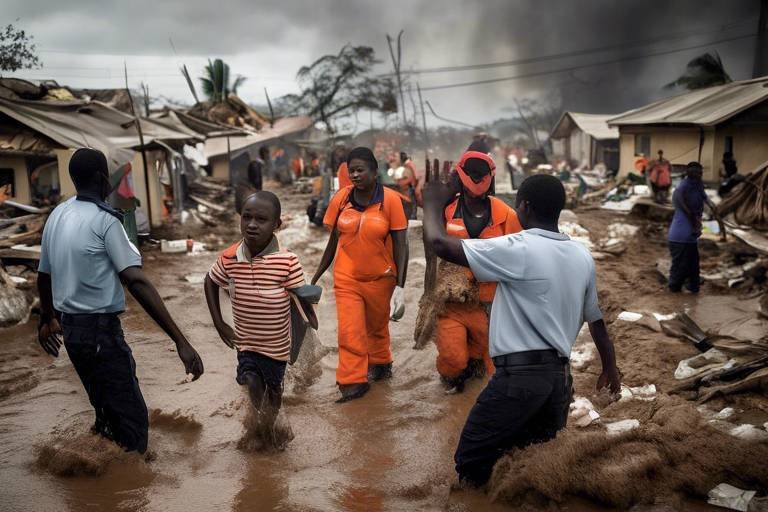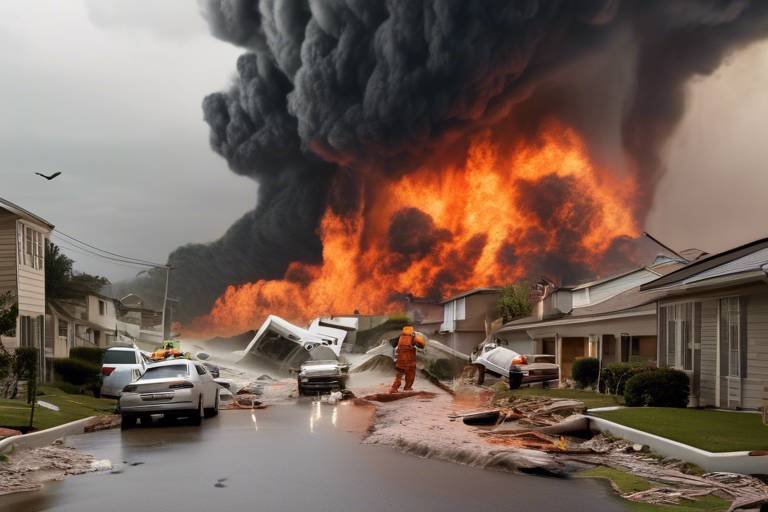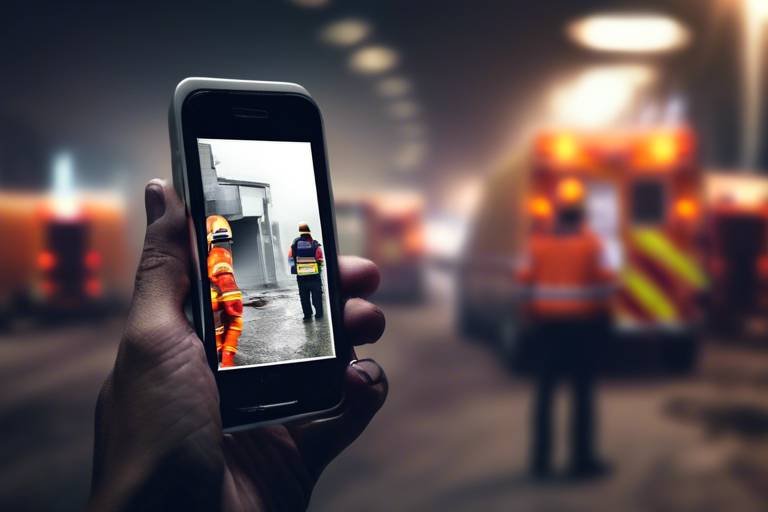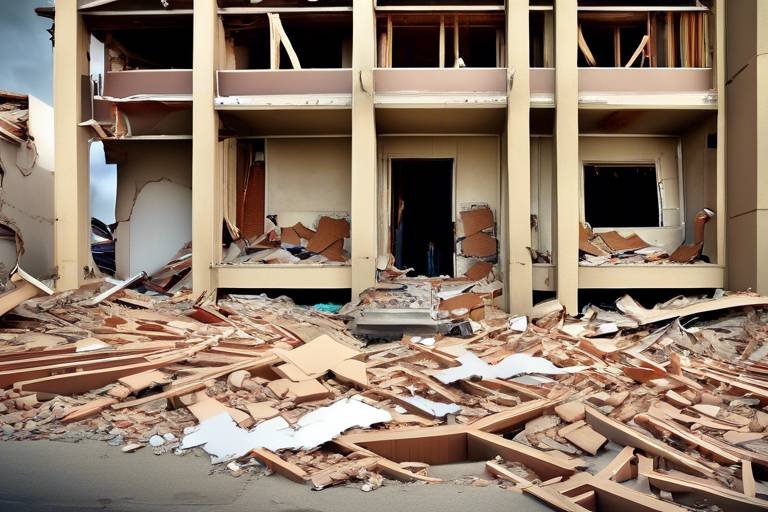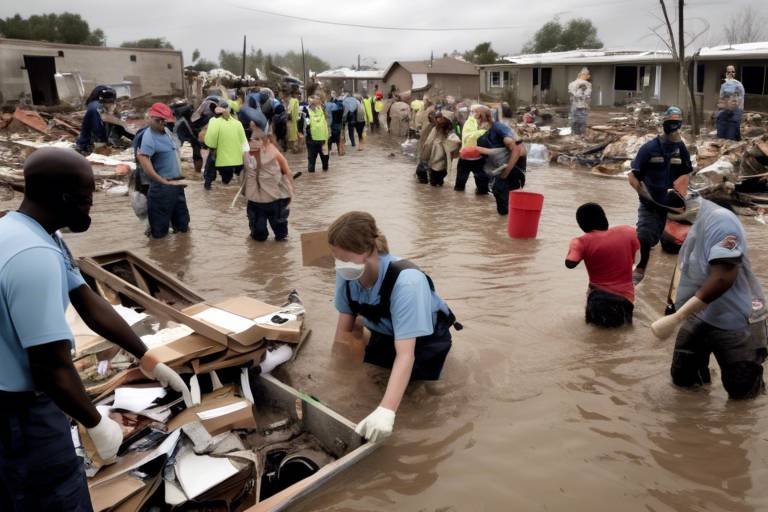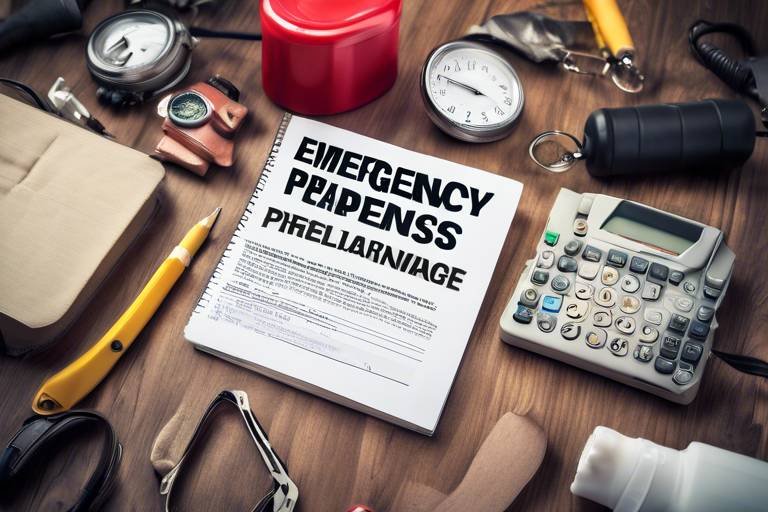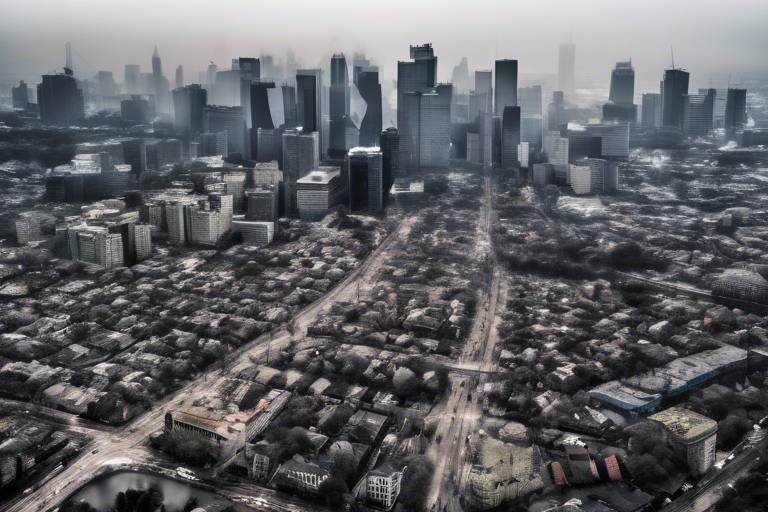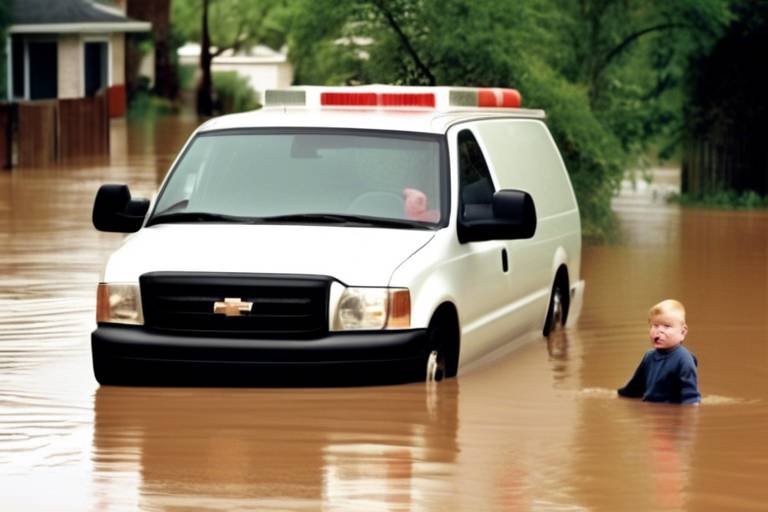Role of Artificial Intelligence in Disaster Management
In today's rapidly evolving world, the role of Artificial Intelligence (AI) in disaster management is nothing short of revolutionary. Imagine a world where technology not only predicts disasters but also aids in saving lives and rebuilding communities. This isn't just a dream; it's becoming a reality thanks to the integration of AI into various aspects of disaster management. From predicting natural disasters to optimizing recovery efforts, AI is transforming how we approach crises. It’s like having a super-smart assistant who can analyze mountains of data in the blink of an eye, helping us make informed decisions that could potentially save countless lives.
As we dive deeper into this topic, we’ll explore the multifaceted applications of AI in disaster management. This journey will uncover how AI not only enhances our preparedness for disasters but also improves our response and recovery efforts. The benefits are immense, but so are the challenges. By understanding both sides, we can better appreciate the transformative impact AI has on disaster management.
One of the most significant contributions of AI in disaster management is its ability to predict disasters. Through advanced algorithms and machine learning techniques, AI analyzes vast datasets, including weather patterns, geological data, and historical records, to improve forecasting accuracy. Have you ever wondered how meteorologists predict hurricanes days in advance? AI is a crucial player in this process, providing timely warnings that can save lives. For instance, AI systems can identify subtle changes in weather conditions that may indicate an impending disaster, allowing authorities to issue alerts and evacuate vulnerable populations ahead of time.
Moreover, AI can enhance the accuracy of earthquake predictions by analyzing seismic data in real-time. This ability to provide early warnings not only helps in saving lives but also minimizes property damage. The integration of AI into disaster prediction is like having a crystal ball that allows us to see potential threats before they materialize, giving us the precious gift of time.
When disaster strikes, every second counts. AI-driven tools are stepping in to assist emergency responders by optimizing resource allocation and improving communication. Picture a scenario where a natural disaster has just occurred. Emergency services are overwhelmed, and chaos reigns. In such situations, AI can analyze real-time data to identify the most affected areas, ensuring that help is dispatched where it is needed the most. This capability is akin to having a GPS system that not only guides you to your destination but also helps you avoid traffic jams.
In the heart of search and rescue operations, AI technologies are making a monumental difference. Drones and robots equipped with AI are revolutionizing how we locate survivors and assess damage in hard-to-reach areas. Imagine a drone soaring above a disaster zone, equipped with thermal imaging to detect heat signatures of trapped individuals. This technology significantly speeds up response times, as rescuers can quickly pinpoint where help is needed the most.
Drones play a vital role in aerial surveillance during disasters. They provide critical information about disaster-affected areas, helping responders assess situations quickly and accurately. With the ability to cover large areas in a short amount of time, drones are like the eyes in the sky that can scout for survivors and identify hazards, allowing ground teams to focus their efforts more effectively.
AI-powered robots are also making waves in hazardous environments. These machines can navigate through debris and dangerous areas, conducting search and rescue missions where human responders may be at risk. This not only enhances safety but also increases efficiency in operations. Imagine sending a robot into a crumbling building to search for survivors while human responders remain safely outside. It’s a game-changer!
AI systems excel at analyzing historical data and real-time information to assess risks associated with potential disasters. This capability is crucial for better planning and preparedness strategies. By understanding patterns and trends, communities can develop proactive measures to minimize potential impacts. It’s like having a weathered sailor who knows the sea’s moods and can navigate through storms with ease.
After the storm has passed, AI continues to play a vital role in post-disaster recovery. By analyzing damage and optimizing rebuilding efforts, AI helps communities return to normalcy more efficiently and effectively. Imagine a community that has just faced a devastating flood. AI can assess the extent of the damage, prioritize areas for rebuilding, and allocate resources where they are needed the most.
AI algorithms can optimize the distribution of resources during recovery efforts. By analyzing data on affected populations and available resources, AI ensures that aid reaches the most impacted areas quickly and efficiently. This level of precision in resource allocation can significantly enhance recovery efforts, making sure that help arrives when it’s needed the most.
Finally, AI-driven platforms facilitate community engagement by collecting feedback and needs from affected populations. This ensures that recovery efforts align with the actual needs of those impacted by disasters. It’s like having an open line of communication where communities can voice their concerns and needs, leading to more effective and tailored recovery strategies.
- How does AI predict disasters? AI uses machine learning algorithms to analyze vast datasets, improving forecasting accuracy and providing timely warnings.
- Can drones really save lives during disasters? Yes, drones equipped with AI can perform aerial surveillance and locate survivors efficiently, significantly speeding up response times.
- What role does AI play in post-disaster recovery? AI helps analyze damage, optimize rebuilding efforts, and ensures that resources are allocated effectively to support recovery.

AI Applications in Disaster Prediction
Artificial Intelligence (AI) is revolutionizing the way we predict disasters, offering unprecedented accuracy and speed. Imagine being able to foresee a hurricane's path or an earthquake's tremors before they happen; this is no longer a distant dream but a reality thanks to the power of AI. By analyzing vast datasets from various sources, including satellite imagery, weather reports, and seismic activity, AI systems can identify patterns that humans might overlook. This capability allows for improved forecasting accuracy, which is crucial in providing timely warnings to communities at risk.
One of the most significant applications of AI in disaster prediction is its ability to process and analyze real-time data. For instance, AI algorithms can sift through thousands of data points from weather stations, social media feeds, and environmental sensors to create a comprehensive picture of the current situation. This data-driven approach not only enhances the quality of predictions but also increases the reliability of early warning systems. As a result, affected populations can receive alerts sooner, giving them more time to prepare and evacuate if necessary.
Moreover, AI's predictive capabilities extend beyond immediate threats. It can also analyze historical data to identify trends and potential future risks. By understanding how disasters have unfolded in the past, AI can help communities develop better preparedness strategies. For example, AI can predict which areas are most likely to flood based on past rainfall patterns and geographical features. This information is invaluable for urban planning and resource allocation, ensuring that communities are better equipped to handle potential disasters.
To illustrate the impact of AI in disaster prediction, consider the following table that summarizes key AI applications:
| AI Application | Description | Impact |
|---|---|---|
| Predictive Analytics | Analyzes historical data and real-time information to forecast disasters. | Improved accuracy in disaster predictions. |
| Machine Learning | Identifies patterns in data to enhance forecasting models. | More reliable early warning systems. |
| Natural Language Processing | Analyzes social media and news reports for real-time updates. | Timely alerts based on public sentiment and information. |
In addition, AI can aid in the integration of various data sources to create a unified disaster management platform. This platform can provide emergency responders, government agencies, and community leaders with real-time insights, facilitating better coordination and response strategies. By utilizing AI-powered tools, these stakeholders can make informed decisions that ultimately save lives and reduce the impact of disasters on communities.
In conclusion, the applications of AI in disaster prediction are vast and varied. From predictive analytics to machine learning, AI technologies enhance our ability to foresee and prepare for disasters. As we continue to harness the power of AI, we can look forward to a future where communities are better protected against the unpredictable forces of nature.

Enhancing Emergency Response with AI
In the face of disasters, time is of the essence. Every second counts, and the ability to respond swiftly can mean the difference between life and death. This is where Artificial Intelligence (AI) steps in, transforming traditional emergency response methods into something far more efficient and effective. By harnessing the power of AI, emergency responders can optimize their operations, ensuring that resources are allocated where they are needed most, communication channels remain open, and real-time decisions are made with precision.
One of the most significant advantages of integrating AI into emergency response is its ability to analyze vast amounts of data in real-time. Imagine a scenario where a hurricane is approaching a coastal city. AI systems can sift through weather patterns, historical data, and even social media feeds to provide accurate forecasts and timely warnings. This level of predictive analytics allows authorities to mobilize resources and evacuate residents before disaster strikes. The result? Fewer lives lost and less damage to property.
Moreover, AI-driven tools enhance communication among emergency responders. In chaotic situations, maintaining clear lines of communication is crucial. AI can facilitate this by providing platforms that allow for seamless information sharing between different agencies and teams. For example, during a wildfire, AI can help coordinate between firefighters, medical personnel, and local authorities, ensuring everyone is on the same page. This coordinated effort not only improves response times but also enhances the overall effectiveness of the emergency response.
When it comes to real-time decision-making, AI shines brightly. With the help of machine learning algorithms, emergency responders can receive immediate insights based on current conditions. For instance, if a flood is occurring, AI can analyze data from sensors placed in various locations to determine which areas are at the highest risk. This information can guide responders in prioritizing their efforts, directing them to the most critical locations first. In this way, AI acts as a force multiplier, amplifying the capabilities of human responders.
Search and rescue operations are often fraught with challenges, especially in the aftermath of a disaster. Here, AI technologies, including drones and robots, are revolutionizing the way these missions are conducted. Imagine a scenario where a building has collapsed due to an earthquake; traditional search methods may take hours or even days to locate survivors trapped beneath the rubble. However, with AI-powered drones, responders can quickly survey the area from above, identifying hotspots where survivors may be located.
Drones equipped with AI technology can perform aerial surveillance, providing critical information about disaster-affected areas. They can cover large distances in a short amount of time, capturing high-resolution images and videos that help responders assess the situation quickly and accurately. This capability is invaluable, especially in large-scale disasters where ground access may be limited. With real-time data streaming back to command centers, decision-makers can strategize their response efforts effectively.
In addition to drones, AI-powered robots are becoming essential tools in hazardous environments. These robots can navigate through debris, search for survivors, and assess damage in areas that are too dangerous for human responders to enter. By deploying robots in such situations, we enhance safety and efficiency in operations. It’s akin to sending in a highly skilled scout to gather vital information before the main team moves in, significantly reducing risks to human life.
In conclusion, the integration of AI into emergency response not only enhances the effectiveness of rescue operations but also saves lives. As technology continues to evolve, we can expect even more innovative solutions that will further empower responders in their critical missions. The future of disaster management is bright, and with AI by our side, we are better equipped than ever to face the challenges that lie ahead.
- How does AI improve disaster prediction? AI analyzes vast datasets to identify patterns and trends, leading to more accurate forecasts and timely warnings.
- Can AI assist in real-time decision-making during emergencies? Yes, AI provides immediate insights based on real-time data, helping responders make informed decisions quickly.
- What role do drones play in emergency response? Drones equipped with AI can conduct aerial surveillance, assess damage, and locate survivors efficiently.
- Are AI-powered robots safe to use in hazardous environments? Absolutely! These robots are designed to operate in dangerous conditions, minimizing risks to human responders.

AI in Search and Rescue Operations
In the face of disasters, every second counts, and the integration of Artificial Intelligence (AI) into search and rescue operations is proving to be a game-changer. Imagine a scenario where a natural disaster strikes, leaving behind a chaotic scene of destruction. Traditional methods of searching for survivors can be painstakingly slow and often dangerous for human responders. However, with the advent of AI technologies, we are witnessing a significant transformation in how these critical operations are conducted. AI not only enhances the speed and efficiency of search efforts but also increases the safety of responders on the ground.
One of the most remarkable applications of AI in search and rescue is the use of drones. Equipped with advanced sensors and AI algorithms, these flying machines can cover vast areas in a fraction of the time it would take a human team. They can analyze real-time data and provide aerial views of disaster-stricken zones, identifying potential survivors and assessing damage from above. Imagine a drone soaring over a collapsed building, using thermal imaging to detect body heat—a task that would be nearly impossible for human rescuers in such perilous conditions. This capability not only speeds up the rescue process but also allows for better planning and resource allocation.
Furthermore, AI-driven robots are making headway in hazardous environments, where human presence may pose significant risks. These robots can navigate through debris, search for trapped individuals, and even deliver supplies to those in need. For instance, consider a scenario where an earthquake has left a community in ruins. An AI-powered robot can maneuver through the rubble, using its sensors to locate survivors and transmit their coordinates to human teams waiting to assist. This synergy between human and machine not only enhances operational efficiency but also minimizes the inherent risks associated with search and rescue missions.
To illustrate the impact of AI in search and rescue, let's take a look at a hypothetical case study. During a recent hurricane, a fleet of drones was deployed to assess the situation in a coastal town. The drones collected data on flooding levels, structural damages, and potential hazards. This information was then analyzed using AI algorithms, enabling emergency responders to prioritize their efforts based on the most affected areas. Here’s a brief overview of how the drones contributed:
| Drone Type | Function | Outcome |
|---|---|---|
| Surveillance Drone | Aerial assessment of flooding | Identified critical areas needing immediate attention |
| Thermal Imaging Drone | Locate survivors in debris | Enabled rapid rescue of trapped individuals |
| Supply Delivery Drone | Transport medical supplies | Provided essential aid to isolated communities |
As we can see from this example, the combination of AI and robotics is not just about technology; it’s about saving lives and restoring hope in the aftermath of disasters. But while the benefits are clear, it’s also important to acknowledge the challenges that come with integrating AI into these operations. Issues such as data privacy, the need for extensive training, and the potential for technology failures must be carefully managed. Nonetheless, the potential of AI to revolutionize search and rescue operations is undeniable, paving the way for a safer and more efficient approach to disaster response.
In conclusion, AI is not merely a tool; it’s a partner in the fight against the chaos that follows disasters. By combining human ingenuity with the analytical power of AI, we are better equipped to tackle the challenges of search and rescue operations, ensuring that no one is left behind in times of crisis.
- How do drones improve search and rescue operations? Drones enhance operations by providing real-time aerial surveillance, quickly identifying survivors, and assessing damage from above.
- What role do robots play in hazardous environments? AI-powered robots can navigate through debris, conduct searches, and deliver supplies, keeping human responders safe from danger.
- Are there any challenges associated with AI in disaster management? Yes, challenges include data privacy concerns, the need for training, and potential technology failures.

Use of Drones for Surveillance
This article explores the transformative impact of artificial intelligence (AI) on disaster management, highlighting its applications, benefits, and challenges in enhancing preparedness, response, and recovery efforts during crises.
AI technologies are increasingly used to predict disasters such as hurricanes and earthquakes, analyzing vast datasets to improve forecasting accuracy and provide timely warnings to affected populations.
AI-driven tools assist emergency responders by optimizing resource allocation, improving communication, and facilitating real-time decision-making during disasters, ultimately saving lives and reducing damage.
AI technologies, including drones and robots, are revolutionizing search and rescue operations by efficiently locating survivors and assessing damage in hard-to-reach areas, significantly speeding up response times.
Drones equipped with AI technology are becoming essential tools in disaster management, particularly for surveillance purposes. Imagine a bird's-eye view of a disaster-stricken area, where every inch is analyzed in real-time to gather crucial information. These drones can fly over affected regions, capturing high-resolution images and videos, which are then processed by AI algorithms to identify damage and assess the situation quickly.
The benefits of using drones for surveillance in disaster scenarios are immense. For instance, they can:
- Access Hard-to-Reach Areas: Drones can easily navigate through obstacles such as rubble, flooding, or blocked roads, providing critical insights that ground teams might miss.
- Conduct Rapid Assessments: With the ability to cover large areas in a short amount of time, drones can deliver real-time data to emergency services, enabling faster decision-making.
- Reduce Risk to Human Lives: By deploying drones in hazardous environments, we minimize the exposure of human responders to potential dangers, allowing them to focus on rescue efforts.
Moreover, drones can be equipped with various sensors, including thermal imaging and LiDAR, which enhance their capability to detect survivors or assess structural integrity. For example, thermal cameras can identify body heat, making it easier to locate individuals trapped under debris, while LiDAR can create detailed 3D maps of the affected area, aiding in planning recovery efforts.
In summary, the use of drones for surveillance during disasters exemplifies how AI can transform emergency response. They not only provide vital information but also ensure that responders can operate safely and effectively, ultimately leading to quicker recovery and saving more lives.
AI plays a crucial role in post-disaster recovery by analyzing damage, optimizing rebuilding efforts, and helping communities return to normalcy more efficiently and effectively.
AI algorithms can optimize the distribution of resources during recovery, ensuring that aid reaches the most affected areas quickly and efficiently, thus enhancing recovery efforts.
AI-driven platforms facilitate community engagement by collecting feedback and needs from affected populations, ensuring that recovery efforts align with the actual needs of those impacted by disasters.
Q1: How do drones improve disaster response?
Drones enhance disaster response by providing real-time data, accessing hard-to-reach areas, and reducing risks to human responders.
Q2: What types of sensors can be used with drones?
Drones can be equipped with thermal imaging, LiDAR, and high-resolution cameras to gather comprehensive data during disaster situations.
Q3: How does AI assist in post-disaster recovery?
AI helps analyze damage, optimize resource distribution, and engage communities to ensure recovery efforts meet the actual needs of affected populations.

Robotic Assistance in Hazardous Environments
When disaster strikes, the aftermath can be chaotic and dangerous, especially in environments that pose significant risks to human responders. This is where AI-powered robots come into play, acting as vital allies in hazardous situations. Imagine a scenario where a building has collapsed due to an earthquake, leaving survivors trapped beneath the rubble. Human rescuers face numerous challenges, including unstable structures and potential aftershocks. In such cases, robots can step in, equipped with advanced sensors and AI algorithms that allow them to navigate treacherous terrains safely.
These robots are designed to perform various tasks that are critical during search and rescue missions. For instance, they can:
- Survey Dangerous Areas: Using cameras and sensors, robots can assess the stability of structures and identify potential hazards, providing real-time data to human teams.
- Locate Survivors: Equipped with thermal imaging and sound detection technologies, robots can pinpoint the location of trapped individuals, even in environments that are too risky for human entry.
- Deliver Supplies: In situations where immediate human intervention is impossible, robots can transport essential supplies such as food, water, and medical aid to those in need.
Moreover, the integration of AI allows these robotic systems to learn from their environments and adapt their strategies accordingly. For example, if a robot encounters an obstacle, it can reconfigure its path in real-time, ensuring that it continues to operate effectively without human intervention. This capability not only enhances the efficiency of rescue operations but also significantly reduces the risks faced by human responders.
Consider the example of a drone equipped with AI technology. It can fly over a disaster zone, mapping out the area while simultaneously identifying hotspots where survivors might be located. This data can then be relayed to human teams on the ground, allowing them to focus their resources more effectively. The combination of aerial surveillance and ground-based robotic assistance creates a comprehensive approach to disaster response, maximizing the chances of saving lives.
However, the deployment of robots in hazardous environments is not without its challenges. Issues such as battery life, communication limitations, and the need for human oversight can complicate their use. Nonetheless, ongoing advancements in technology are continuously improving the capabilities of these robots, making them an indispensable part of modern disaster management strategies.
In summary, AI-powered robots are revolutionizing the way we approach disaster response in hazardous environments. Their ability to operate in dangerous conditions, coupled with their advanced analytical capabilities, makes them invaluable assets for saving lives and ensuring the safety of human responders. As technology continues to evolve, we can expect even more innovative applications of robotics in disaster management, paving the way for a safer and more efficient response to emergencies.

Data Analysis and Risk Assessment
The role of artificial intelligence (AI) in data analysis and risk assessment is nothing short of revolutionary, especially in the context of disaster management. Imagine trying to predict a storm's path or an earthquake's impact without the ability to analyze vast amounts of data in real-time. It would be like navigating a ship through fog without a compass. AI changes that game entirely. By leveraging advanced algorithms and machine learning techniques, AI systems can sift through historical data, weather patterns, seismic activity, and even social media trends to provide a clearer picture of potential risks.
One of the most significant advantages of using AI in this field is its ability to process and analyze data at an unprecedented scale. Traditional methods often rely on human analysts who can only examine a limited amount of information. In contrast, AI can analyze thousands of data points simultaneously, identifying patterns and correlations that might go unnoticed by the human eye. For instance, AI can predict which areas are most vulnerable to flooding by analyzing rainfall data, topography, and historical flood records, thereby enabling better planning and resource allocation.
Furthermore, AI enhances risk assessment by utilizing real-time data. This means that as a disaster unfolds, AI systems can continuously update their analyses, providing emergency responders with the most current information. Imagine a wildfire spreading rapidly; AI can analyze satellite imagery, weather conditions, and vegetation data to predict the fire's path and inform evacuation plans. This real-time capability is crucial for minimizing harm and ensuring that resources are directed where they are needed most.
To illustrate the impact of AI in data analysis and risk assessment, consider the following table that outlines some key applications:
| Application | Description | Benefits |
|---|---|---|
| Predictive Analytics | Uses historical data to forecast future disasters. | Improves preparedness and response strategies. |
| Real-Time Monitoring | Analyzes live data feeds from various sources. | Enhances decision-making during crises. |
| Risk Mapping | Creates visual maps of vulnerable areas. | Facilitates targeted interventions and resource allocation. |
Additionally, AI can help in the development of risk models that simulate various disaster scenarios. These models can be invaluable for governments and organizations as they prepare for potential disasters. By understanding how different factors interact, stakeholders can develop more effective emergency response plans. For example, a risk model might simulate the impact of a hurricane hitting a coastal city, taking into account variables like population density, infrastructure resilience, and evacuation routes. This kind of foresight can save lives and property.
However, while the benefits of AI in data analysis and risk assessment are substantial, there are challenges to consider. Data privacy and security are paramount, as sensitive information must be protected from misuse. Moreover, the accuracy of AI predictions depends heavily on the quality of the data fed into these systems. If the data is flawed or biased, the outcomes can be misleading. Hence, continuous improvement and validation of AI models are essential to ensure their reliability in critical situations.
In conclusion, AI's role in data analysis and risk assessment is transforming how we approach disaster management. By harnessing the power of data, we can better prepare for, respond to, and recover from disasters, ultimately saving lives and reducing the impact on communities. The future of disaster management is not just about reacting to crises; it’s about predicting and preventing them through informed decision-making.
- How does AI improve disaster prediction? AI analyzes large datasets to identify patterns and trends that help forecast disasters more accurately.
- What role do drones play in disaster management? Drones equipped with AI provide aerial surveillance, helping responders assess damage and locate survivors quickly.
- Can AI help in post-disaster recovery? Yes, AI optimizes resource allocation and facilitates community engagement to ensure recovery efforts meet the actual needs of affected populations.

AI in Post-Disaster Recovery
When the dust settles after a disaster, the real challenge begins: how to rebuild and recover effectively. This is where artificial intelligence (AI) steps in as a game changer. Imagine having a supercharged assistant that can analyze mountains of data faster than any human could, pinpointing exactly where help is needed the most. AI systems can evaluate the extent of damage, assess community needs, and prioritize recovery efforts in a way that is both efficient and effective.
One of the critical roles of AI in post-disaster recovery is its ability to analyze damage assessments. Traditional methods of evaluating destruction can be slow and labor-intensive, often leading to delays in aid distribution. With AI, however, we can leverage satellite imagery and aerial drone footage to assess damage in real-time. For instance, AI algorithms can analyze images to identify areas that require immediate attention, allowing responders to focus their efforts where they are needed most. This not only speeds up the recovery process but also ensures that resources are allocated effectively.
Moreover, AI plays a pivotal role in optimizing rebuilding efforts. By analyzing historical data and current conditions, AI can help urban planners and policymakers make informed decisions about how to rebuild infrastructure. For example, AI can recommend designs that are more resilient to future disasters, ensuring that communities are better prepared for whatever nature throws their way. This proactive approach can significantly reduce the time it takes for communities to return to a state of normalcy.
In addition to these technical applications, AI also enhances community engagement in recovery efforts. AI-driven platforms can collect feedback from affected populations, allowing them to voice their needs and concerns. This is crucial because, after a disaster, the affected communities often know best what they need to recover. By using AI to analyze this feedback, recovery efforts can be tailored to meet the actual needs of the people, rather than relying solely on assumptions made by external agencies.
Furthermore, the integration of AI in recovery processes can lead to a more equitable distribution of resources. For example, AI algorithms can analyze demographic data and historical trends to ensure that aid is directed to the most vulnerable populations. This ensures that no one is left behind in the recovery process, fostering a sense of community resilience and solidarity.
To illustrate the impact of AI in post-disaster recovery, consider the following table that summarizes key benefits:
| Benefit | Description |
|---|---|
| Speed | AI accelerates damage assessment and resource allocation, enabling quicker response times. |
| Efficiency | Optimizes resource distribution to ensure aid reaches those in greatest need. |
| Community-Centric | Facilitates engagement with affected populations to tailor recovery efforts effectively. |
| Future Preparedness | Informs rebuilding strategies that enhance resilience against future disasters. |
In conclusion, the role of AI in post-disaster recovery is not just about technology; it's about humanity. It’s about ensuring that communities can bounce back stronger, smarter, and more united than ever before. As we continue to face the challenges posed by natural disasters, embracing AI could be the key to transforming our recovery efforts into a more effective and compassionate process.
- How does AI help in damage assessment after a disaster? AI analyzes satellite images and drone footage to quickly evaluate the extent of damage, allowing for faster resource allocation.
- Can AI ensure that aid reaches the most vulnerable populations? Yes, AI algorithms can analyze demographic data to optimize the distribution of resources, ensuring equity in recovery efforts.
- What role does community feedback play in AI-driven recovery? AI platforms collect and analyze community feedback to tailor recovery efforts according to the actual needs of the affected populations.
- Is AI capable of predicting future disasters to improve recovery? While AI excels in analyzing data for current situations, it also aids in understanding patterns that can inform future preparedness strategies.

Resource Allocation for Recovery Efforts
In the wake of a disaster, one of the most critical challenges faced by relief organizations is the effective allocation of resources. This is where artificial intelligence (AI) steps in as a game-changer. Imagine a world where every bottle of water, every medical supply, and every piece of equipment is delivered exactly where it’s needed, when it’s needed. AI algorithms analyze vast amounts of data, including real-time information about the affected areas, to ensure that resources are distributed efficiently.
For instance, AI can evaluate factors such as population density, the severity of damage, and accessibility of roads to determine the most effective routes for aid delivery. This not only speeds up the recovery process but also ensures that the most vulnerable populations receive assistance first. By utilizing historical data alongside current conditions, AI can predict which areas will require more resources based on past disaster responses, creating a proactive approach to recovery.
Moreover, AI systems can assist in prioritizing needs based on community feedback. By analyzing social media posts, text messages, and calls made to emergency hotlines, AI can identify urgent needs and adjust resource allocation dynamically. This kind of responsiveness is crucial in chaotic situations where every minute counts.
To illustrate the impact of AI on resource allocation, consider the following table that outlines how traditional methods compare to AI-driven approaches in post-disaster scenarios:
| Aspect | Traditional Methods | AI-Driven Methods |
|---|---|---|
| Data Analysis | Manual assessment, slow response | Real-time data processing, rapid insights |
| Resource Allocation | Generalized distribution | Targeted distribution based on needs |
| Community Engagement | Feedback collected post-disaster | Continuous feedback during disaster |
| Efficiency | Delayed aid delivery | Timely aid delivery |
Ultimately, the integration of AI into recovery efforts not only enhances the efficiency of resource allocation but also fosters a sense of community involvement. As affected individuals can voice their needs through AI platforms, the recovery process becomes more inclusive and responsive. This leads to a more resilient community that is better prepared for future disasters. By leveraging technology, we can transform the way we respond to crises, ensuring that no one is left behind in the aftermath of calamities.
- How does AI improve resource allocation in disaster recovery?
AI improves resource allocation by analyzing real-time data, predicting needs based on historical patterns, and dynamically adjusting resource distribution to ensure that the most affected areas receive timely assistance.
- What types of data does AI analyze for disaster recovery?
AI analyzes various data types, including social media posts, emergency call logs, demographic information, and geographic data, to assess the needs of affected communities accurately.
- Can AI completely replace human decision-making in disaster recovery?
No, AI is designed to assist and enhance human decision-making, not replace it. Human expertise is crucial for interpreting AI insights and making final decisions in complex situations.
- Are there any challenges in using AI for disaster management?
Yes, challenges include data privacy concerns, the need for reliable data sources, and the potential for technology to malfunction or be misinterpreted in high-pressure situations.

Community Engagement through AI Platforms
In the wake of a disaster, the voices of the affected communities are often drowned out in the chaos. However, artificial intelligence is stepping in to change that narrative. AI platforms are revolutionizing how communities engage during and after crises, ensuring that their needs are prioritized and addressed. Imagine a scenario where survivors can easily communicate their immediate needs through a simple app, and that information is analyzed in real-time to direct resources where they are most needed. This is not just a dream; it’s a reality made possible by AI.
One of the key advantages of AI in community engagement is its ability to process vast amounts of data quickly. For instance, during a natural disaster, AI systems can analyze social media posts, texts, and other forms of communication to identify urgent needs and sentiments among the population. This data can then be used to inform local authorities and aid organizations about what the community truly requires, rather than relying solely on assumption or outdated information.
Moreover, AI platforms facilitate two-way communication between responders and communities. Through chatbots and interactive applications, individuals can report issues, ask questions, and provide feedback on the assistance they are receiving. This not only empowers the community but also helps responders adjust their strategies based on real-time input. For example, if a community reports a lack of medical supplies, the AI can flag this to the relevant agencies, ensuring that help is directed swiftly.
Furthermore, AI-driven platforms can enhance community engagement by creating a feedback loop. After a disaster, these systems can gather data on the effectiveness of recovery efforts. Questions like “Was the aid sufficient?” or “Did the communication channels work well?” can be posed to the community, allowing for a thorough assessment of the response efforts. This not only helps improve future disaster management strategies but also fosters a sense of trust and collaboration between the community and responders.
In addition, AI can help in creating personalized recovery plans. By analyzing individual needs and preferences, AI platforms can suggest tailored resources and support systems for each community member. This level of personalization ensures that recovery efforts are not one-size-fits-all but are instead responsive to the unique characteristics of each community.
In summary, the integration of AI platforms in disaster management is a game-changer for community engagement. By harnessing the power of technology, we can ensure that the voices of those affected are heard loud and clear, leading to more effective and compassionate disaster response and recovery efforts.
- How does AI improve communication during disasters?
AI enhances communication by analyzing real-time data from various sources, allowing for timely updates and alerts to be sent to affected communities. - Can AI platforms replace human responders?
No, AI platforms are designed to assist human responders, providing them with critical information and insights to make informed decisions during disasters. - What role do community members play in AI-driven platforms?
Community members provide essential feedback and data that help shape disaster response strategies, ensuring that their needs are met effectively.
Frequently Asked Questions
- What role does AI play in disaster prediction?
AI plays a crucial role in disaster prediction by analyzing vast datasets to identify patterns and trends. This allows for improved forecasting accuracy, enabling timely warnings for natural disasters like hurricanes and earthquakes. By leveraging machine learning algorithms, AI can process historical data and real-time information, making it possible to predict disasters more effectively than traditional methods.
- How does AI enhance emergency response during disasters?
AI enhances emergency response by optimizing resource allocation, improving communication among responders, and facilitating real-time decision-making. This technology enables teams to act swiftly and efficiently, ultimately saving lives and reducing potential damage. For instance, AI tools can analyze the situation on the ground and suggest the best course of action, allowing for a more coordinated and effective response.
- Can AI assist in search and rescue operations?
Absolutely! AI technologies, such as drones and robots, are revolutionizing search and rescue missions. Drones equipped with AI can perform aerial surveillance, quickly locating survivors and assessing damage in hard-to-reach areas. Meanwhile, AI-powered robots can navigate hazardous environments, conducting missions where human responders might be at risk, thus enhancing safety and efficiency.
- What is the significance of data analysis in disaster management?
Data analysis is vital in disaster management as it allows for better risk assessment and preparedness strategies. AI systems can analyze historical and real-time data to evaluate potential risks, helping communities to plan effectively for future disasters. By understanding past events, responders can develop strategies that minimize impacts and improve resilience.
- How does AI contribute to post-disaster recovery?
In post-disaster recovery, AI helps analyze damage and optimize rebuilding efforts. It can streamline the distribution of resources, ensuring that aid reaches the most affected areas quickly. Additionally, AI-driven platforms facilitate community engagement by collecting feedback from those impacted, ensuring that recovery efforts align with their actual needs.


